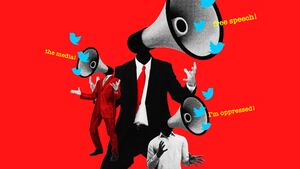Six years ago, NYU social psychologist and author Jonathan Haidt co-authored The Coddling of the American Mind. In the book, he and Greg Lukianoff argued that parents are doing a real disservice to their kids by overprotecting (coddling) them, rather than giving them more freedom and allowing them to make mistakes and learn.
This year, he’s back with a new book, The Anxious Generation, arguing the exact opposite in the digital world: that social media and smartphones have made kids under-protected, rewiring brains and increasing teenage depression rates.
Haidt tries to address this obvious contradiction in his book with the standard cop-out of the purveyor of every modern moral panic: “This time it’s different!” He provides little evidence to support that.
In this new book, Haidt is coddling the American parent: providing them with a clear, simple, and wrong solution to what is ailing their children. But—as with historic moral panics—parents, schools, and politicians will embrace it, absolving themselves of their own failings in raising children in our modern world and pointing to an easy villain.
You Can Only Massage the Data So Much
Unfortunately for those seeking an easy solution, the data doesn’t support Haidt’s conclusions.
Over the last decade, numerous studies on the impact of phones and social media on children, including a “study of studies,” conclude that social media is good for some kids, helping them find like-minded individuals. It’s mostly neutral for many kids, and problematic for only a very small group (studies suggest less than 10 percent).
Candice Odgers, the author of one of the meta-studies, notes in her review of Haidt’s book that the evidence suggests the causality is likely in the other direction.
It’s not that social media causes mental health problems in that group. Rather, those struggling with mental issues—and who can’t find help elsewhere—often turn to social media to cope. Getting them actual help would be a solution. Cutting off social media, without anything else, could make their situation worse, rather than better.
Reading Haidt’s book, you might think the evidence supports his viewpoint, as he presents a lot of it. The problem is that he’s cherry-picking his evidence and often relying on flawed studies. Many other studies by those who have studied this field for many years (unlike Haidt), find little to no support for Haidt’s analysis. The American Psychological Association, which is often quick to blame new technologies for harms (it did this with video games), admitted recently that in a review of all the research, social media could not be deemed as “inherently beneficial or harmful to young people.”
Two recent studies from the Internet Institute at Oxford used access it had obtained to huge amounts of data that showed no direct connection between screen time and mental health or social media and mental health. The latter study there involved data on nearly 1 million people across 72 countries, comparing the introduction of Facebook with widely collected data on mental health, finding little to support a claim that social media diminishes mental health.
To get around this unfortunate situation, Haidt seems to carefully pick which data he uses to support his argument. For example, Haidt mentions the increase in depression and suicide among teen girls from 2000 to the present. The numbers started rising around 2010, though they are still relatively low.
What’s left out if you start in 2000 is what happened earlier. Prior to 2000, the numbers were on par with what they were today in the late 1980s and early 1990s, when no social media existed. Across the decades, we see that the late ’90s and early 2000s were a time when depression and suicide rates significantly dipped from previous highs, before returning recently to similar levels from the ’80s and ’90s.
It’s worth studying why it dropped and then why it went up again, but by starting the data in 2000, Haidt ignores that story, focusing only on the increase, and leading readers to the false conclusion that we are in a unique and therefore alarming period that can only be blamed on social media.
Haidt ties this to his earlier beliefs that the lack of outdoor play by kids is a problem. He cites psychology professor Peter Gray's research, including his recent meta-study in the Journal of Pediatrics on the decline in children’s mental well-being. The study concludes that the lack of unsupervised play is the leading cause.
However, Haidt conspicuously leaves out an important bit of information. In that same paper, Gray and his co-authors conclude that the research does not support the premise that social media has anything to do with the decline in mental health. Gray and his co-authors state, “systematic reviews of research into this have provided little support for the contention that either total screen time or time involved with social media is a major cause of, or even correlate of, declining mental health.”
Apparently, Haidt only cites the parts of Gray’s work that match his thesis, and not the parts that don’t.
Similarly, while some have pointed out many other potential causes to an increase in depression and suicide rates today—pointing to such things as the Great Recession of 2007 to 2009—Haidt often responds by pointing out that the rates of depression increased globally, not just in the U.S.
But that appears to be wrong.
Looking at suicide rates (which are more indicative of actual depression rates, rather than self-reported data, given the decreasing stigma associated with admitting to dealing with mental health issues), the numbers show that in many countries it has remained flat or decreased over the past 20 years. Indeed, in countries like France, Ireland, Denmark, Spain, and New Zealand, you see a noticeable decline in youth suicide rates.
If social media were inherently causing an increase in depression, that would be an unlikely result.
Indeed, another research report from Adriana Corredor-Waldron and Janet Currie, notes that even where we see increases in reports of suicide and depression among children in the U.S., we should be cautious, as much of it may be due to changes in both mental health screening and coding practices. Specifically, they note new guidance in the U.S. under the Affordable Care Act in 2011 that increased screening of adolescent girls for depression (the rise in depression rates for adolescent girls being key to Haidt’s argument), and a second change in instructing clinicians to record suicidal ideation differently than in the past.
The conclusion of the paper is not that mental health of adolescents has gotten any worse, but rather that we’ve now improved screening and diagnostic practices to discover it. Coming at a time when the stigma about mental health has declined somewhat, and when people are more willing to discuss mental health publicly, there are reasons to question Haidt’s reliance on data that might not tell the story he believes.
Moral Panics Come and Go, But They Never Fix Real Problems
While it doesn’t make it directly into his latest book, while he was working on it, Haidt responded to critics of his thesis by citing Pascal’s Wager—that it makes more sense to believe in God than not, because the cost of believing and being wrong is nothing. But the cost of not believing and being wrong could be eternal damnation.
Similarly, Haidt argues that we should keep kids away from social media for the same reason: even if he’s wrong, the “cost” is minimal.
The scariest part is that the cost of being wrong is not minimal. Indeed, it appears to be extremely high.
If he’s wrong, it means parents, politicians, teachers, and more do not tackle the real root causes of teenage mental health issues.

The research has shown repeatedly that social media is valuable for many young people, especially those struggling in their local communities and families (multiple studies highlight how LGBTQ youth rely heavily on social media in very helpful ways). Taking that lifeline away can be damaging. There are numerous stories of kids who relied on social media to help them out of tricky situations, such as diagnosing a disease where doctors failed to help.
Similarly, Haidt is no policy expert, and it shows. In the book, he supports policies like the “Kids Online Safety Act,” which has been condemned by LGBTQ groups, given that the co-sponsor of the bill has admitted she supports it to remove LGBTQ content from the internet. That’s real harm.
He also comes out in support of “Age Appropriate Design Codes” (AADC), despite the fact that California’s attempt to pass that has been deemed unconstitutional, as it would require websites to remove constitutionally protected content.
Haidt only acknowledges this turn of events in an endnote, though he completely misrepresents the legal challenges and why the court ruled as it did. He brushes aside those concerns as simply being about Big Tech not wanting to embrace these laws (which is wrong, as they’ve supported most of these laws, knowing it creates barriers to startups and entrenches their positions). The reality is that, in practice, AADC laws have been found to stifle often important content.
The Markup recently published a story about schools that attempted to block problematic content such as pornography, cheating, and harmful content for kids. But what really happened was they ended up blocking sites that were useful for kids, including the Trevor Project (which provides suicide prevention resources and tools directed mainly at LGBTQ youth), Planned Parenthood, and more.
Indeed, whenever people who don’t spend much time working in these areas (such as Haidt) venture into them, they often fail to understand the complexities, nuances, and tradeoffs of their proposals. For example, there has been a prolonged effort to get social media websites to remove “eating disorder content.” Both KOSA and AADC laws would likely require as much.
However, multiple studies found that removing eating disorder content likely resulted in more harm than help, in that users still sought out that content (often through alternate keywords) and often found it on even more dangerous sites. When such content was allowed on more mainstream sites, it also came with resources and users who tried to guide people towards recovery. When it was suppressed on those sites, users seeking such content often went to places that were much worse, and encouraged dangerous behavior. That is, the removal of “dangerous” content, likely created more dangerous outcomes.
These efforts can lead to real harms.
Haidt also supports age verification, even as it has been mostly declared unconstitutional and a huge privacy risk. France’s data protection agency, CNIL, reviewed the technology in 2022 and found that there were no options that would adequately protect privacy. In the book, Haidt suggests that privacy risks can be cured by having a third party “verify” someone’s age and giving websites a “yes” or “no” token, thereby inserting an extra layer to keep identity separate from the site someone visits.
The problem is that this shows a deep lack of understanding of how any of this works. Such a system still creates very real privacy problems.
How does the third party provider verify ages and not create a huge privacy target? How do websites authenticate that the person who verified their age with the provider is the person who is visiting their site? Haidt seems excited that age verification providers have their very own trade group, but leaves out that the trade group believes the best way to verify ages is to make users take a video of their face to visit a website, which raises all sorts of questions about both privacy and the quality of the technology.
Incredibly, given how much Haidt points to data and studies in the first half of the book, when he gets to his policy proposals, he presents no studies or data to support the claims that literally any of his solutions would help.
He suggests raising the age at which kids can use certain websites from 13 to 16. Why 16? Based on his gut. He literally says he “thinks” age 16 “was the right one for the minimum age,” but presents no research or data to explain why. He notes that at that age they’re mature enough to handle the internet, though he doesn’t explain why.
And why suggest limiting access to age 16, rather than teaching kids digital literacy and how to better use the internet to avoid harms? He doesn’t say. He just decides what he thinks is right.
Yet, we have actual evidence on this already, regarding the age of 13, which (as Haidt notes) is built into the Children’s Online Privacy Protection Act (COPPA). Researcher Danah Boyd studied this years ago, finding that the actual result of the age 13 limit in COPPA was parents teaching kids to lie about their age, so that they could use these tools to do things like talk to grandparents and friends.
Some of Haidt’s suggestions are so disconnected from any actual research or data as to raise questions about exactly where he’s coming from. There’s an entire chapter talking about how the kids these days just need to be more spiritual and religious, which seems like an odd and out of place discussion in a book about social media (and, on a separate note there is at least some research suggesting that kids today are finding spirituality via social media).
When even his former co-author, Lukianoff, pointed out that Haidt’s proposals clearly violate the First Amendment, Haidt’s only response is to suggest that if First Amendment advocates get together, he’s sure they can figure out ways to do age verification that is Constitutional.
This is the classic “nerd harder” demands of a non-expert insisting that if actual experts try hard enough, surely they can make the impossible possible.
The actual harms to getting this wrong could be tremendous. By coddling the American parent, and letting them think they can cure what ails kids by simply limiting their internet access, real harm can be caused.
Kids who actually do rely on the internet to find community and social interactions could grow further isolated. Even worse, it stops parents and teachers from dealing with actual triggers and actual problems, allowing them to brush it off as “too much TikTok,” rather than whatever real cause might be at play. It also stops them from training kids how to use social media safely, which is an important skill these days.
Treating social media as inherently harmful for all kids (when the data, at best, suggests only a very small percentage struggle with it), also would remove a useful and helpful tool from many who can be taught to use it properly, to protect a small number of users who were not taught how to use it properly. Wouldn’t a better solution be to focus on helping everyone to use the tools properly and in an age appropriate manner?
Meet the New Panic, Same as the Old Panic
Every generation has its own moral panic. Throughout history everything from the waltz, to chess, to novels, to pinball, to rock ’n’ roll, to roleplaying games. Each time, someone comes along and tries to support the moral panic with some form of “this time it’s different.” This time it’s Jonathan Haidt.
Haidt has responded to these claims of him supporting a moral panic by arguing that some moral panics are, in fact, real threats—using examples like teen smoking and drunk driving.
Yet, those are examples of literal physical dangers from consumable materials (nicotine and alcohol). Social media is not consumed into the body. These things are not comparable. Every single moral panic based on media has later proven to be laughably off-base.
Amusingly, Haidt references a different recent moral panic in defending this latest one: video games. In the late 1990s and early 2000s, there was a huge moral panic around video games, until the research caught up and (as with social media) could find no causal link between video games and negative behavior.
Haidt, incredibly, embraces some forms of video game playing (the video games he played, apparently) but complains about the kids these days and their video games, which involve multiplayer setups where they actually interact with other players around the world. He notes (without any supporting evidence) that, in the past, kids would get together to play video games, but today they do so “alone in their bedrooms.”
Where is the data to support this? Where is the data to support that kids playing multiplayer video games are somehow having worse outcomes than those who played multiplayer video games two decades ago?
This sort of problem is found throughout the book. What data Haidt presents is cherry-picked and presented only in a manner to prop up his arguments. Contrary data (of which there is a lot) is ignored. His policy proposals are based on gut feels, not research, and a lack of understanding of the complexities and tradeoffs inherent in the approaches he supports.
In the end, neither the data nor reality support his position, and neither should you. Kids and mental health is a very complex issue, and Haidt’s solution appears to be, in the words of H.L. Mencken: clear, simple, and wrong.











